February 26, 1982
To the Shareholders of Berkshire Hathaway Inc.:
Operating earnings of $39.7 million in 1981 amounted to
15.2% of beginning equity capital (valuing securities at cost)
compared to 17.8% in 1980. Our new plan that allows stockholders
to designate corporate charitable contributions (detailed later)
reduced earnings by about $900,000 in 1981. This program, which
we expect to continue subject to annual evaluation of our
corporate tax position, had not been initiated in 1980.
Non-Controlled Ownership Earnings
In the 1980 annual report we discussed extensively the
concept of non-controlled ownership earnings, i.e., Berkshire’s
share of the undistributed earnings of companies we don’t control
or significantly influence but in which we, nevertheless, have
important investments. (We will be glad to make available to new
or prospective shareholders copies of that discussion or others
from earlier reports to which we refer in this report.) No
portion of those undistributed earnings is included in the
operating earnings of Berkshire.
However, our belief is that, in aggregate, those
undistributed and, therefore, unrecorded earnings will be
translated into tangible value for Berkshire shareholders just as
surely as if subsidiaries we control had earned, retained - and
reported - similar earnings.
We know that this translation of non-controlled ownership
earnings into corresponding realized and unrealized capital gains
for Berkshire will be extremely irregular as to time of
occurrence. While market values track business values quite well
over long periods, in any given year the relationship can gyrate
capriciously. Market recognition of retained earnings also will
be unevenly realized among companies. It will be disappointingly
low or negative in cases where earnings are employed non-
productively, and far greater than dollar-for-dollar of retained
earnings in cases of companies that achieve high returns with
their augmented capital. Overall, if a group of non-controlled
companies is selected with reasonable skill, the group result
should be quite satisfactory.
In aggregate, our non-controlled business interests have
more favorable underlying economic characteristics than our
controlled businesses. That’s understandable; the area of choice
has been far wider. Small portions of exceptionally good
businesses are usually available in the securities markets at
reasonable prices. But such businesses are available for
purchase in their entirety only rarely, and then almost always at
high prices.
General Acquisition Behavior
As our history indicates, we are comfortable both with total
ownership of businesses and with marketable securities
representing small portions of businesses. We continually look
for ways to employ large sums in each area. (But we try to avoid
small commitments - “If something’s not worth doing at all, it’s
not worth doing well”.) Indeed, the liquidity requirements of our
B
E
R
K
S
H
I
R
E
H
A
T
H
A
W
A
Y
I
N
C
.
�
insurance and trading stamp businesses mandate major investments
in marketable securities.
Our acquisition decisions will be aimed at maximizing real
economic benefits, not at maximizing either managerial domain or
reported numbers for accounting purposes. (In the long run,
managements stressing accounting appearance over economic
substance usually achieve little of either.)
Regardless of the impact upon immediately reportable
earnings, we would rather buy 10% of Wonderful Business T at X
per share than 100% of T at 2X per share. Most corporate
managers prefer just the reverse, and have no shortage of stated
rationales for their behavior.
However, we suspect three motivations - usually unspoken -
to be, singly or in combination, the important ones in most high-
premium takeovers:
(1) Leaders, business or otherwise, seldom are deficient in
animal spirits and often relish increased activity and
challenge. At Berkshire, the corporate pulse never
beats faster than when an acquisition is in prospect.
(2) Most organizations, business or otherwise, measure
themselves, are measured by others, and compensate their
managers far more by the yardstick of size than by any
other yardstick. (Ask a Fortune 500 manager where his
corporation stands on that famous list and, invariably,
the number responded will be from the list ranked by
size of sales; he may well not even know where his
corporation places on the list Fortune just as
faithfully compiles ranking the same 500 corporations by
profitability.)
(3) Many managements apparently were overexposed in
impressionable childhood years to the story in which the
imprisoned handsome prince is released from a toad’s
body by a kiss from a beautiful princess. Consequently,
they are certain their managerial kiss will do wonders
for the profitability of Company T(arget).
Such optimism is essential. Absent that rosy view,
why else should the shareholders of Company A(cquisitor)
want to own an interest in T at the 2X takeover cost
rather than at the X market price they would pay if they
made direct purchases on their own?
In other words, investors can always buy toads at the
going price for toads. If investors instead bankroll
princesses who wish to pay double for the right to kiss
the toad, those kisses had better pack some real
dynamite. We’ve observed many kisses but very few
miracles. Nevertheless, many managerial princesses
remain serenely confident about the future potency of
their kisses - even after their corporate backyards are
knee-deep in unresponsive toads.
In fairness, we should acknowledge that some acquisition
records have been dazzling. Two major categories stand out.
The first involves companies that, through design or
accident, have purchased only businesses that are particularly
well adapted to an inflationary environment. Such favored
business must have two characteristics: (1) an ability to
increase prices rather easily (even when product demand is flat
and capacity is not fully utilized) without fear of significant
loss of either market share or unit volume, and (2) an ability to
accommodate large dollar volume increases in business (often
�
produced more by inflation than by real growth) with only minor
additional investment of capital. Managers of ordinary ability,
focusing solely on acquisition possibilities meeting these tests,
have achieved excellent results in recent decades. However, very
few enterprises possess both characteristics, and competition to
buy those that do has now become fierce to the point of being
self-defeating.
The second category involves the managerial superstars - men
who can recognize that rare prince who is disguised as a toad,
and who have managerial abilities that enable them to peel away
the disguise. We salute such managers as Ben Heineman at
Northwest Industries, Henry Singleton at Teledyne, Erwin Zaban at
National Service Industries, and especially Tom Murphy at Capital
Cities Communications (a real managerial “twofer”, whose
acquisition efforts have been properly focused in Category 1 and
whose operating talents also make him a leader of Category 2).
From both direct and vicarious experience, we recognize the
difficulty and rarity of these executives’ achievements. (So do
they; these champs have made very few deals in recent years, and
often have found repurchase of their own shares to be the most
sensible employment of corporate capital.)
Your Chairman, unfortunately, does not qualify for Category
2. And, despite a reasonably good understanding of the economic
factors compelling concentration in Category 1, our actual
acquisition activity in that category has been sporadic and
inadequate. Our preaching was better than our performance. (We
neglected the Noah principle: predicting rain doesn’t count,
building arks does.)
We have tried occasionally to buy toads at bargain prices
with results that have been chronicled in past reports. Clearly
our kisses fell flat. We have done well with a couple of princes
- but they were princes when purchased. At least our kisses
didn’t turn them into toads. And, finally, we have occasionally
been quite successful in purchasing fractional interests in
easily-identifiable princes at toad-like prices.
Berkshire Acquisition Objectives
We will continue to seek the acquisition of businesses in
their entirety at prices that will make sense, even should the
future of the acquired enterprise develop much along the lines of
its past. We may very well pay a fairly fancy price for a
Category 1 business if we are reasonably confident of what we are
getting. But we will not normally pay a lot in any purchase for
what we are supposed to bring to the party - for we find that we
ordinarily don’t bring a lot.
During 1981 we came quite close to a major purchase
involving both a business and a manager we liked very much.
However, the price finally demanded, considering alternative uses
for the funds involved, would have left our owners worse off than
before the purchase. The empire would have been larger, but the
citizenry would have been poorer.
Although we had no success in 1981, from time to time in the
future we will be able to purchase 100% of businesses meeting our
standards. Additionally, we expect an occasional offering of a
major “non-voting partnership” as discussed under the Pinkerton’s
heading on page 47 of this report. We welcome suggestions
regarding such companies where we, as a substantial junior
partner, can achieve good economic results while furthering the
long-term objectives of present owners and managers.
Currently, we find values most easily obtained through the
open-market purchase of fractional positions in companies with
�
excellent business franchises and competent, honest managements.
We never expect to run these companies, but we do expect to
profit from them.
We expect that undistributed earnings from such companies
will produce full value (subject to tax when realized) for
Berkshire and its shareholders. If they don’t, we have made
mistakes as to either: (1) the management we have elected to
join; (2) the future economics of the business; or (3) the price
we have paid.
We have made plenty of such mistakes - both in the purchase
of non-controlling and controlling interests in businesses.
Category (2) miscalculations are the most common. Of course, it
is necessary to dig deep into our history to find illustrations
of such mistakes - sometimes as deep as two or three months back.
For example, last year your Chairman volunteered his expert
opinion on the rosy future of the aluminum business. Several
minor adjustments to that opinion - now aggregating approximately
180 degrees - have since been required.
For personal as well as more objective reasons, however, we
generally have been able to correct such mistakes far more
quickly in the case of non-controlled businesses (marketable
securities) than in the case of controlled subsidiaries. Lack of
control, in effect, often has turned out to be an economic plus.
As we mentioned last year, the magnitude of our non-recorded
“ownership” earnings has grown to the point where their total is
greater than our reported operating earnings. We expect this
situation will continue. In just four ownership positions in
this category - GEICO Corporation, General Foods Corporation, R.
J. Reynolds Industries, Inc. and The Washington Post Company -
our share of undistributed and therefore unrecorded earnings
probably will total well over $35 million in 1982. The
accounting rules that entirely ignore these undistributed
earnings diminish the utility of our annual return on equity
calculation, or any other single year measure of economic
performance.
Long-Term Corporate Performance
In measuring long-term economic performance, equities held
by our insurance subsidiaries are valued at market subject to a
charge reflecting the amount of taxes that would have to be paid
if unrealized gains were actually realized. If we are correct in
the premise stressed in the preceding section of this report, our
unreported ownership earnings will find their way, irregularly
but inevitably, into our net worth. To date, this has been the
case.
An even purer calculation of performance would involve a
valuation of bonds and non-insurance held equities at market.
However, GAAP accounting does not prescribe this procedure, and
the added purity would change results only very slightly. Should
any valuation difference widen to significant proportions, as it
has at most major insurance companies, we will report its effect
to you.
On a GAAP basis, during the present management’s term of
seventeen years, book value has increased from $19.46 per share
to $526.02 per share, or 21.1% compounded annually. This rate of
return number is highly likely to drift downward in future years.
We hope, however, that it can be maintained significantly above
the rate of return achieved by the average large American
corporation.
Over half of the large gain in Berkshire’s net worth during
�
1981 - it totaled $124 million, or about 31% - resulted from the
market performance of a single investment, GEICO Corporation. In
aggregate, our market gain from securities during the year
considerably outstripped the gain in underlying business values.
Such market variations will not always be on the pleasant side.
In past reports we have explained how inflation has caused
our apparently satisfactory long-term corporate performance to be
illusory as a measure of true investment results for our owners.
We applaud the efforts of Federal Reserve Chairman Volcker and
note the currently more moderate increases in various price
indices. Nevertheless, our views regarding long-term
inflationary trends are as negative as ever. Like virginity, a
stable price level seems capable of maintenance, but not of
restoration.
Despite the overriding importance of inflation in the
investment equation, we will not punish you further with another
full recital of our views; inflation itself will be punishment
enough. (Copies of previous discussions are available for
masochists.) But, because of the unrelenting destruction of
currency values, our corporate efforts will continue to do a much
better job of filling your wallet than of filling your stomach.
Equity Value-Added
An additional factor should further subdue any residual
enthusiasm you may retain regarding our long-term rate of return.
The economic case justifying equity investment is that, in
aggregate, additional earnings above passive investment returns -
interest on fixed-income securities - will be derived through the
employment of managerial and entrepreneurial skills in
conjunction with that equity capital. Furthermore, the case says
that since the equity capital position is associated with greater
risk than passive forms of investment, it is “entitled” to higher
returns. A “value-added” bonus from equity capital seems natural
and certain.
But is it? Several decades back, a return on equity of as
little as 10% enabled a corporation to be classified as a “good”
business - i.e., one in which a dollar reinvested in the business
logically could be expected to be valued by the market at more
than one hundred cents. For, with long-term taxable bonds
yielding 5% and long-term tax-exempt bonds 3%, a business
operation that could utilize equity capital at 10% clearly was
worth some premium to investors over the equity capital employed.
That was true even though a combination of taxes on dividends and
on capital gains would reduce the 10% earned by the corporation
to perhaps 6%-8% in the hands of the individual investor.
Investment markets recognized this truth. During that
earlier period, American business earned an average of 11% or so
on equity capital employed and stocks, in aggregate, sold at
valuations far above that equity capital (book value), averaging
over 150 cents on the dollar. Most businesses were “good”
businesses because they earned far more than their keep (the
return on long-term passive money). The value-added produced by
equity investment, in aggregate, was substantial.
That day is gone. But the lessons learned during its
existence are difficult to discard. While investors and managers
must place their feet in the future, their memories and nervous
systems often remain plugged into the past. It is much easier
for investors to utilize historic p/e ratios or for managers to
utilize historic business valuation yardsticks than it is for
either group to rethink their premises daily. When change is
slow, constant rethinking is actually undesirable; it achieves
little and slows response time. But when change is great,
�
yesterday’s assumptions can be retained only at great cost. And
the pace of economic change has become breathtaking.
During the past year, long-term taxable bond yields exceeded
16% and long-term tax-exempts 14%. The total return achieved
from such tax-exempts, of course, goes directly into the pocket
of the individual owner. Meanwhile, American business is
producing earnings of only about 14% on equity. And this 14%
will be substantially reduced by taxation before it can be banked
by the individual owner. The extent of such shrinkage depends
upon the dividend policy of the corporation and the tax rates
applicable to the investor.
Thus, with interest rates on passive investments at late
1981 levels, a typical American business is no longer worth one
hundred cents on the dollar to owners who are individuals. (If
the business is owned by pension funds or other tax-exempt
investors, the arithmetic, although still unenticing, changes
substantially for the better.) Assume an investor in a 50% tax
bracket; if our typical company pays out all earnings, the income
return to the investor will be equivalent to that from a 7% tax-
exempt bond. And, if conditions persist - if all earnings are
paid out and return on equity stays at 14% - the 7% tax-exempt
equivalent to the higher-bracket individual investor is just as
frozen as is the coupon on a tax-exempt bond. Such a perpetual
7% tax-exempt bond might be worth fifty cents on the dollar as
this is written.
If, on the other hand, all earnings of our typical American
business are retained and return on equity again remains
constant, earnings will grow at 14% per year. If the p/e ratio
remains constant, the price of our typical stock will also grow
at 14% per year. But that 14% is not yet in the pocket of the
shareholder. Putting it there will require the payment of a
capital gains tax, presently assessed at a maximum rate of 20%.
This net return, of course, works out to a poorer rate of return
than the currently available passive after-tax rate.
Unless passive rates fall, companies achieving 14% per year
gains in earnings per share while paying no cash dividend are an
economic failure for their individual shareholders. The returns
from passive capital outstrip the returns from active capital.
This is an unpleasant fact for both investors and corporate
managers and, therefore, one they may wish to ignore. But facts
do not cease to exist, either because they are unpleasant or
because they are ignored.
Most American businesses pay out a significant portion of
their earnings and thus fall between the two examples. And most
American businesses are currently “bad” businesses economically -
producing less for their individual investors after-tax than the
tax-exempt passive rate of return on money. Of course, some
high-return businesses still remain attractive, even under
present conditions. But American equity capital, in aggregate,
produces no value-added for individual investors.
It should be stressed that this depressing situation does
not occur because corporations are jumping, economically, less
high than previously. In fact, they are jumping somewhat higher:
return on equity has improved a few points in the past decade.
But the crossbar of passive return has been elevated much faster.
Unhappily, most companies can do little but hope that the bar
will be lowered significantly; there are few industries in which
the prospects seem bright for substantial gains in return on
equity.
Inflationary experience and expectations will be major (but
not the only) factors affecting the height of the crossbar in
future years. If the causes of long-term inflation can be
�
tempered, passive returns are likely to fall and the intrinsic
position of American equity capital should significantly improve.
Many businesses that now must be classified as economically “bad”
would be restored to the “good” category under such
circumstances.
A further, particularly ironic, punishment is inflicted by
an inflationary environment upon the owners of the “bad”
business. To continue operating in its present mode, such a low-
return business usually must retain much of its earnings - no
matter what penalty such a policy produces for shareholders.
Reason, of course, would prescribe just the opposite policy.
An individual, stuck with a 5% bond with many years to run before
maturity, does not take the coupons from that bond and pay one
hundred cents on the dollar for more 5% bonds while similar bonds
are available at, say, forty cents on the dollar. Instead, he
takes those coupons from his low-return bond and - if inclined to
reinvest - looks for the highest return with safety currently
available. Good money is not thrown after bad.
What makes sense for the bondholder makes sense for the
shareholder. Logically, a company with historic and prospective
high returns on equity should retain much or all of its earnings
so that shareholders can earn premium returns on enhanced
capital. Conversely, low returns on corporate equity would
suggest a very high dividend payout so that owners could direct
capital toward more attractive areas. (The Scriptures concur. In
the parable of the talents, the two high-earning servants are
rewarded with 100% retention of earnings and encouraged to expand
their operations. However, the non-earning third servant is not
only chastised - “wicked and slothful” - but also is required to
redirect all of his capital to the top performer. Matthew 25:
14-30)
But inflation takes us through the looking glass into the
upside-down world of Alice in Wonderland. When prices
continuously rise, the “bad” business must retain every nickel
that it can. Not because it is attractive as a repository for
equity capital, but precisely because it is so unattractive, the
low-return business must follow a high retention policy. If it
wishes to continue operating in the future as it has in the past
- and most entities, including businesses, do - it simply has no
choice.
For inflation acts as a gigantic corporate tapeworm. That
tapeworm preemptively consumes its requisite daily diet of
investment dollars regardless of the health of the host organism.
Whatever the level of reported profits (even if nil), more
dollars for receivables, inventory and fixed assets are
continuously required by the business in order to merely match
the unit volume of the previous year. The less prosperous the
enterprise, the greater the proportion of available sustenance
claimed by the tapeworm.
Under present conditions, a business earning 8% or 10% on
equity often has no leftovers for expansion, debt reduction or
“real” dividends. The tapeworm of inflation simply cleans the
plate. (The low-return company’s inability to pay dividends,
understandably, is often disguised. Corporate America
increasingly is turning to dividend reinvestment plans, sometimes
even embodying a discount arrangement that all but forces
shareholders to reinvest. Other companies sell newly issued
shares to Peter in order to pay dividends to Paul. Beware of
“dividends” that can be paid out only if someone promises to
replace the capital distributed.)
Berkshire continues to retain its earnings for offensive,
not defensive or obligatory, reasons. But in no way are we
�
immune from the pressures that escalating passive returns exert
on equity capital. We continue to clear the crossbar of after-
tax passive return - but barely. Our historic 21% return - not
at all assured for the future - still provides, after the current
capital gain tax rate (which we expect to rise considerably in
future years), a modest margin over current after-tax rates on
passive money. It would be a bit humiliating to have our
corporate value-added turn negative. But it can happen here as
it has elsewhere, either from events outside anyone’s control or
from poor relative adaptation on our part.
Sources of Reported Earnings
The table below shows the sources of Berkshire’s reported
earnings. Berkshire owns about 60% of Blue Chip Stamps which, in
turn, owns 80% of Wesco Financial Corporation. The table
displays aggregate operating earnings of the various business
entities, as well as Berkshire’s share of those earnings. All of
the significant gains and losses attributable to unusual sales of
assets by any of the business entities are aggregated with
securities transactions in the line near the bottom of the table
and are not included in operating earnings.
Net Earnings
Earnings Before Income Taxes After Tax
-------------------------------------- ------------------
Total Berkshire Share Berkshire Share
------------------ ------------------ ------------------
1981 1980 1981 1980 1981 1980
-------- -------- -------- -------- -------- --------
(000s omitted)
Operating Earnings:
Insurance Group:
Underwriting ............ $ 1,478 $ 6,738 $ 1,478 $ 6,737 $ 798 $ 3,637
Net Investment Income ... 38,823 30,939 38,823 30,927 32,401 25,607
Berkshire-Waumbec Textiles (2,669) (508) (2,669) (508) (1,493) 202
Associated Retail Stores .. 1,763 2,440 1,763 2,440 759 1,169
See’s Candies ............. 21,891 15,475 13,046 9,223 6,289 4,459
Buffalo Evening News ...... (1,057) (2,777) (630) (1,655) (276) (800)
Blue Chip Stamps - Parent 3,642 7,699 2,171 4,588 2,134 3,060
Wesco Financial - Parent .. 4,495 2,916 2,145 1,392 1,590 1,044
Mutual Savings and Loan ... 1,605 5,814 766 2,775 1,536 1,974
Precision Steel ........... 3,453 2,833 1,648 1,352 841 656
Interest on Debt .......... (14,656) (12,230) (12,649) (9,390) (6,671) (4,809)
Other* .................... 1,895 1,698 1,344 1,308 1,513 992
-------- -------- -------- -------- -------- --------
Sub-total - Continuing
Operations ............. $ 60,663 $ 61,037 $ 47,236 $ 49,189 $ 39,421 $ 37,191
Illinois National Bank** .. -- 5,324 -- 5,200 -- 4,731
-------- -------- -------- -------- -------- --------
Operating Earnings .......... 60,663 66,361 47,236 54,389 39,421 41,922
Sales of securities and
unusual sales of assets .. 37,801 19,584 33,150 15,757 23,183 11,200
-------- -------- -------- -------- -------- --------
Total Earnings - all entities $ 98,464 $ 85,945 $ 80,386 $ 70,146 $ 62,604 $ 53,122
======== ======== ======== ======== ======== ========
*Amortization of intangibles arising in accounting for
purchases of businesses (i.e. See’s, Mutual and Buffalo
Evening News) is reflected in the category designated as
“Other”.
**Berkshire divested itself of its ownership of the Illinois
National Bank on December 31, 1980.
Blue Chip Stamps and Wesco are public companies with
reporting requirements of their own. On pages 38-50 of this
report we have reproduced the narrative reports of the principal
�
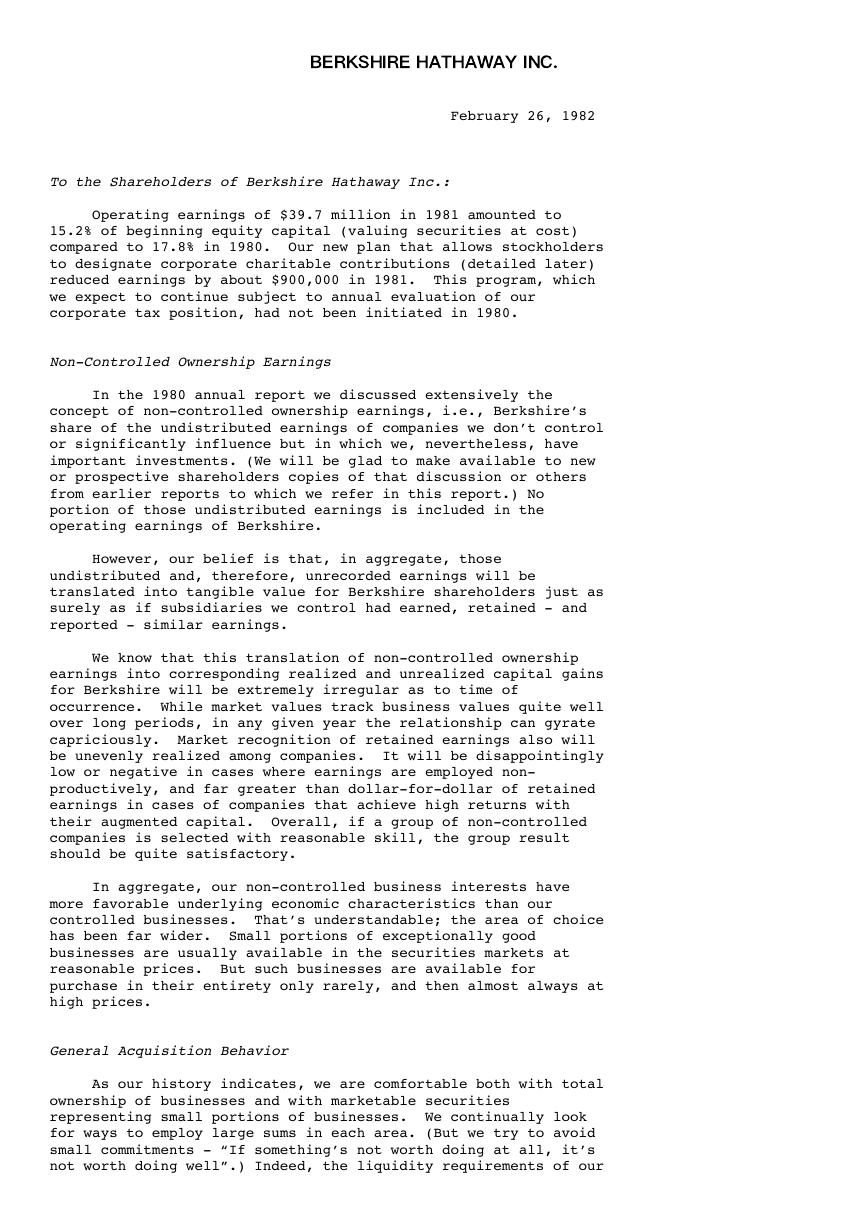
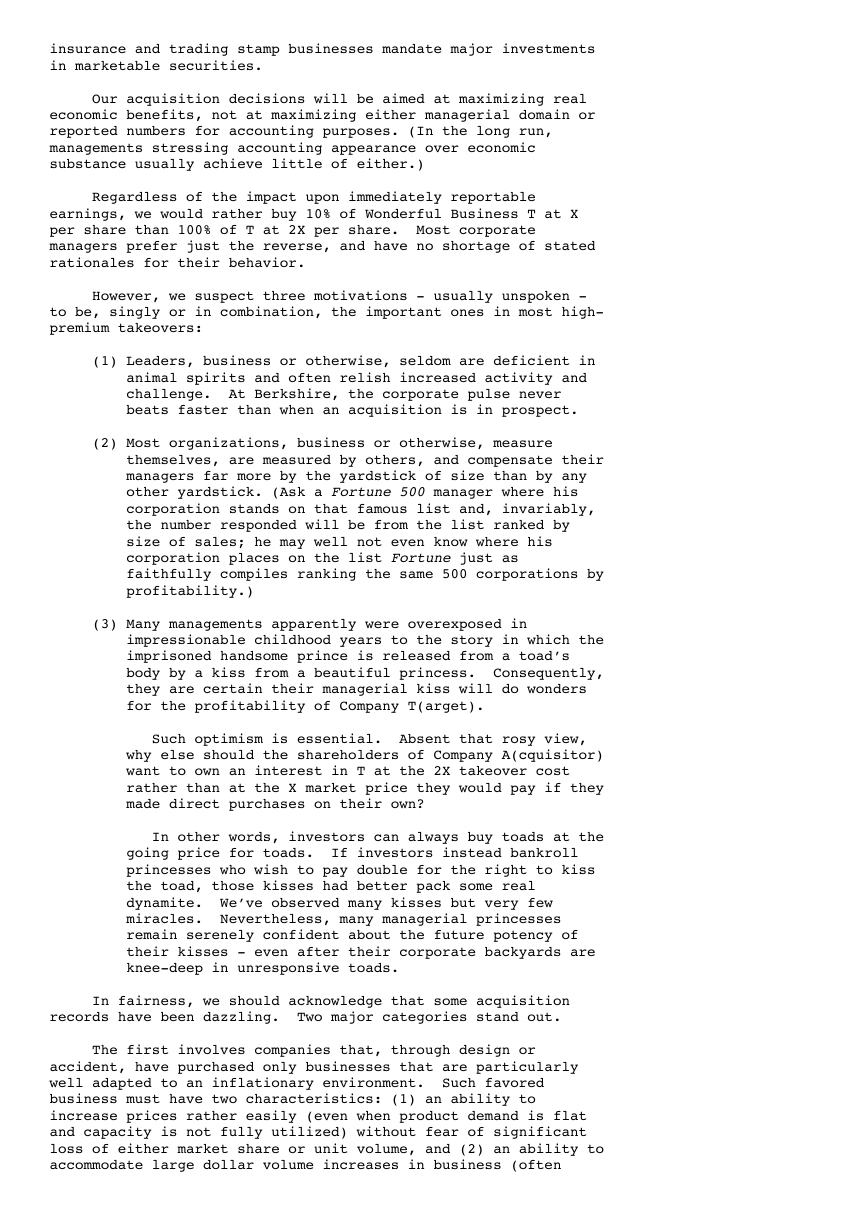
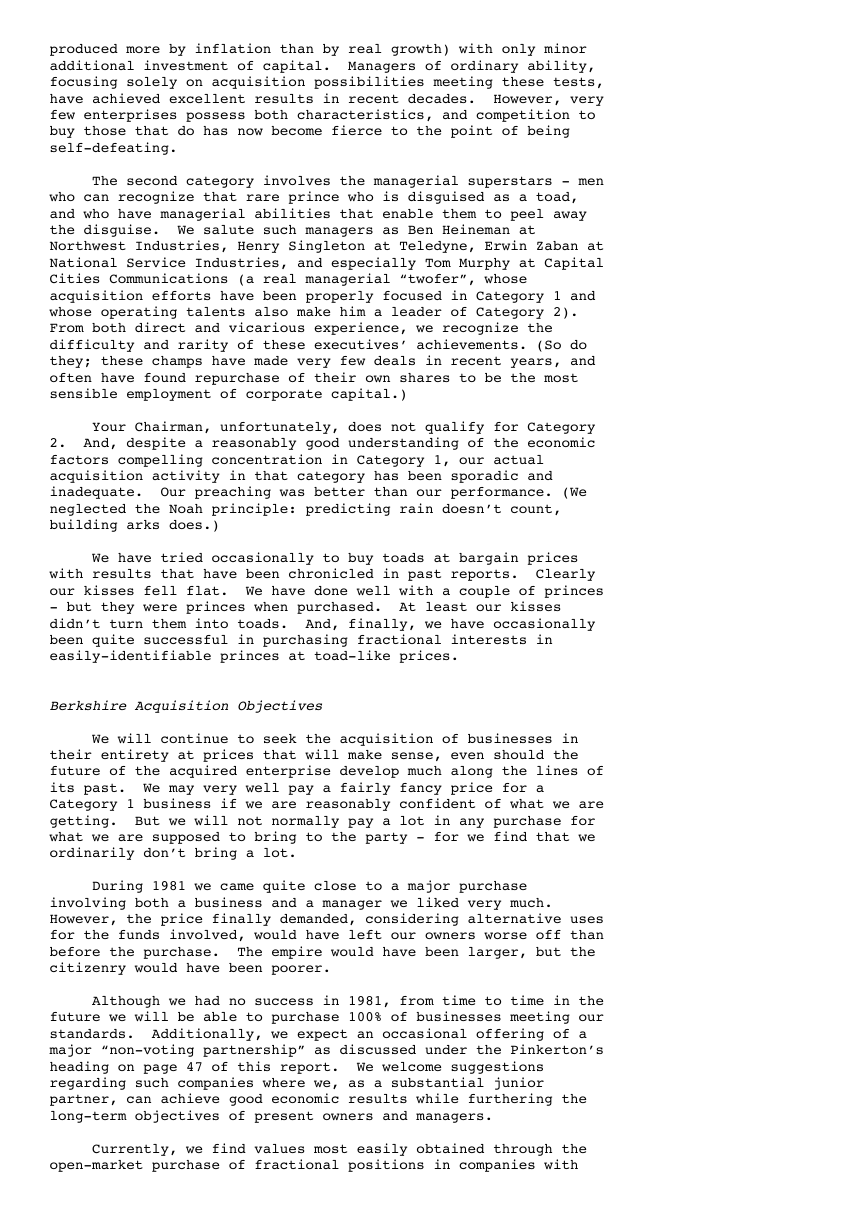
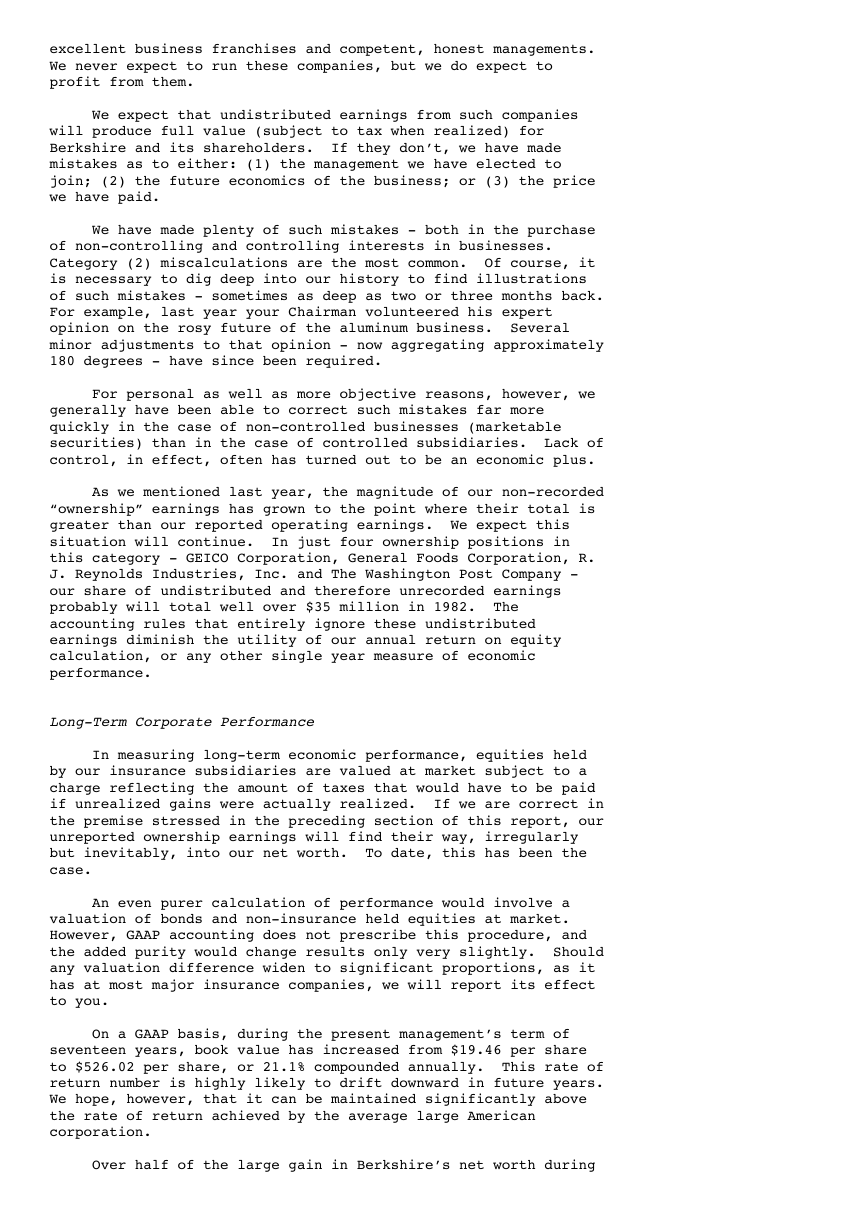

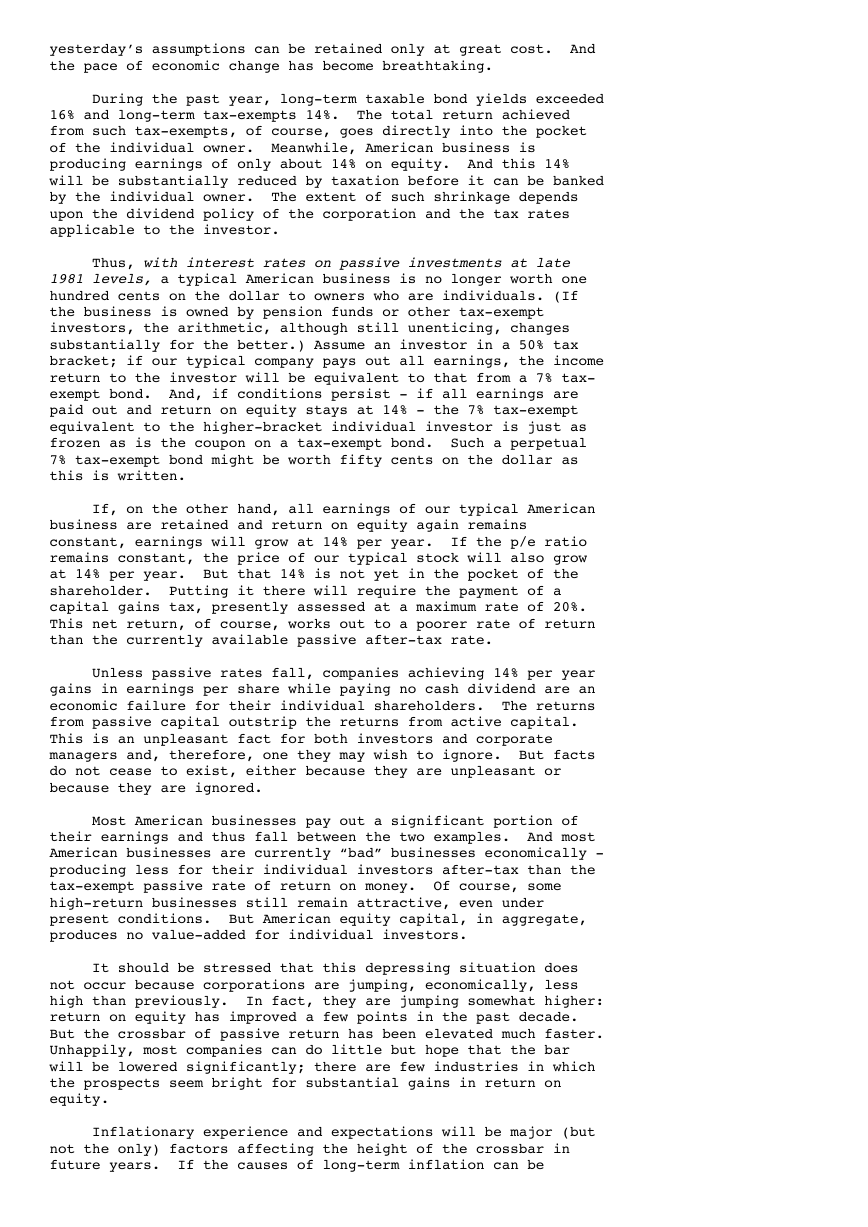
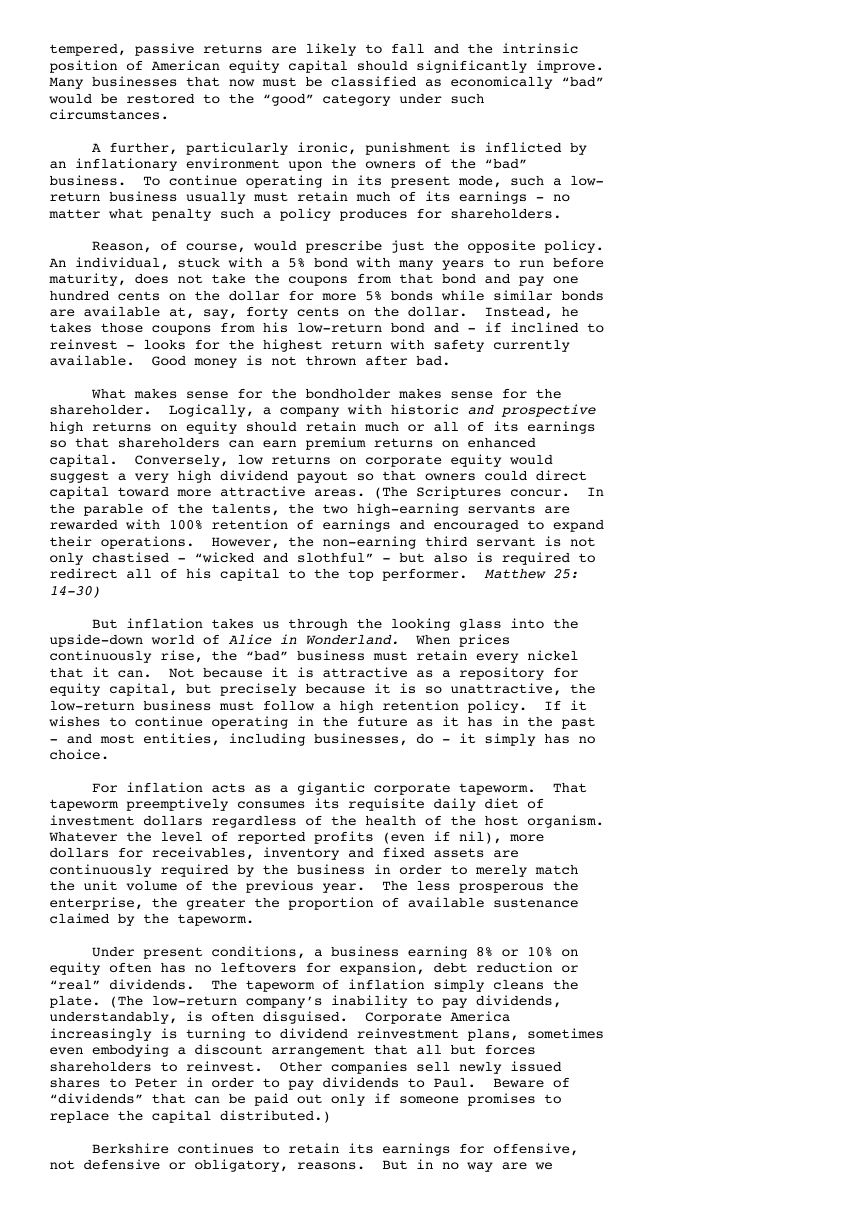
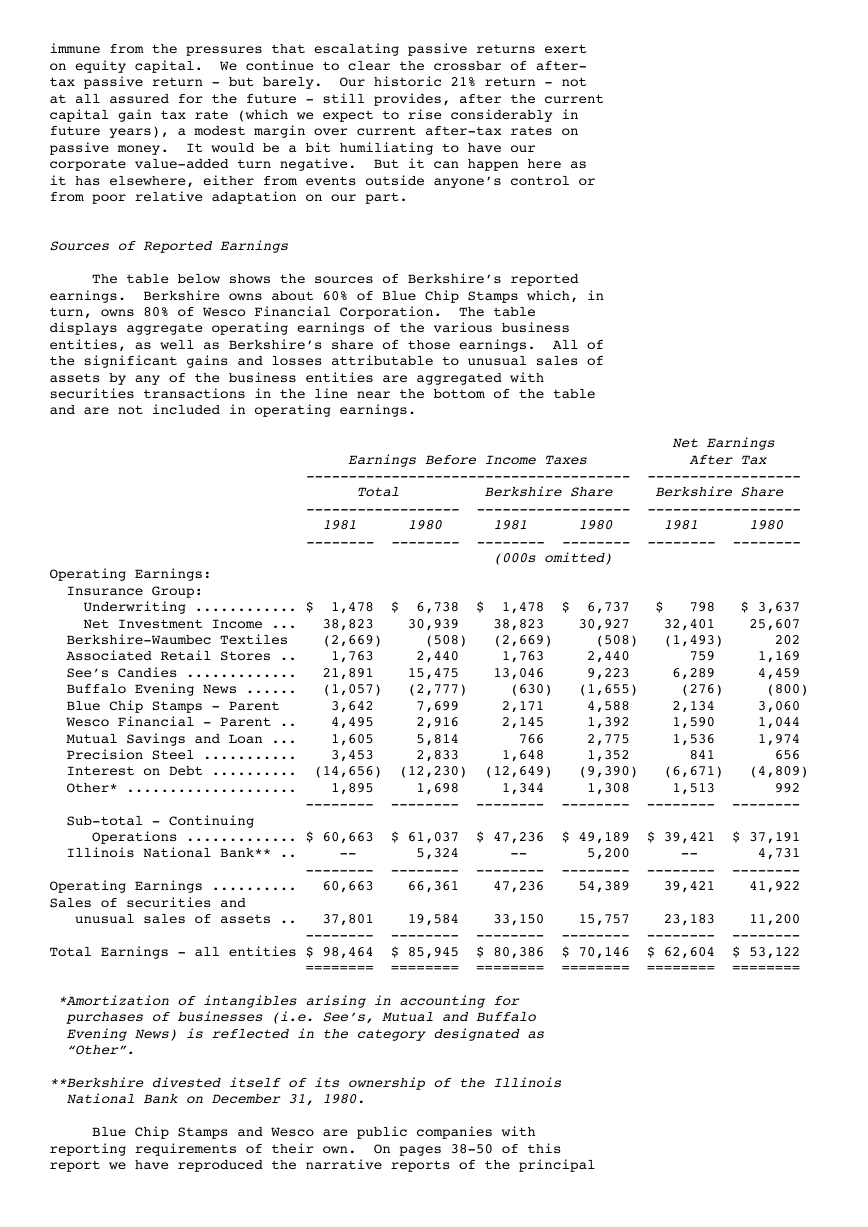








 uCOS-III的任务调度算法研究.pdf
uCOS-III的任务调度算法研究.pdf STM32F103x8B_DS_CH_V10(7STM32中文数据手册).pdf
STM32F103x8B_DS_CH_V10(7STM32中文数据手册).pdf FX2N系列PLC培训教程.pdf
FX2N系列PLC培训教程.pdf Modbus协议资料.pdf
Modbus协议资料.pdf WM8978中文资料(芯片资料).doc
WM8978中文资料(芯片资料).doc 5-1.【Codelab】HarmonyOS基于图像模块实现图库图片的四种常见操作.pdf
5-1.【Codelab】HarmonyOS基于图像模块实现图库图片的四种常见操作.pdf GX Developer 编程软件使用说明.pdf
GX Developer 编程软件使用说明.pdf MR-E伺服与FX3G接线图.pdf
MR-E伺服与FX3G接线图.pdf ATK-NEO-6M GPS模块常见问题汇总_201400721.pdf
ATK-NEO-6M GPS模块常见问题汇总_201400721.pdf STM32F407ZGT6(芯片资料).pdf
STM32F407ZGT6(芯片资料).pdf FM1715编程指南.pdf
FM1715编程指南.pdf Profibus教程-7.PROFIBUS-FMS.pdf
Profibus教程-7.PROFIBUS-FMS.pdf